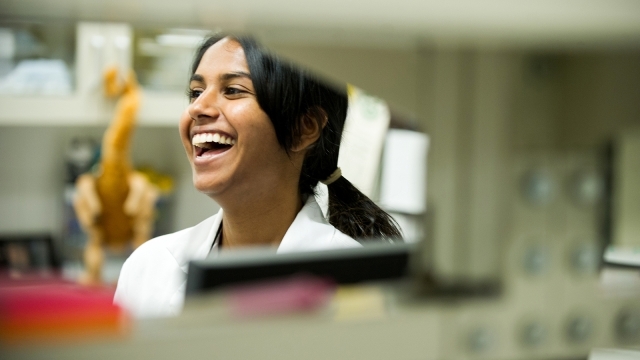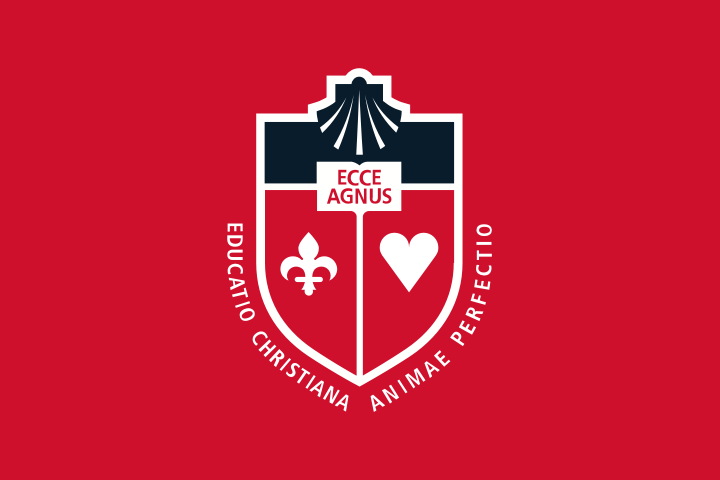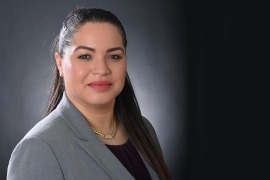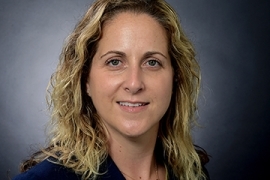

UG
Radiologic Sciences, Bachelor of Sciences
This program is a rigorous course of study, combining didactic and laboratory-based academic instruction with clinical training at leading New York-area hospitals, medical centers, and private medical practices.
- Home
- Academics
- Majors and Programs of Study
- Radiologic Sciences, Bachelor of Sciences
St. John’s University’s College of Pharmacy and Health Sciences offers an undergraduate program leading to a Bachelor of Science degree in Radiologic Sciences. This program is a rigorous course of study, combining didactic and laboratory-based academic instruction with clinical training at leading New York-area hospitals, medical centers, and private medical practices.
Upon completion of the program, graduates are eligible to take the national board examination in Radiography administered by the American Registry of Radiologic Technologists (ARRT) and upon successful completion are afforded a New York State Department of Health (NYSDOH) license to practice as a Radiologic Technologist. Graduates may advance into more specialized areas including but not limited to Computer Tomography (CT), Magnetic Resonance Imaging (MRI), and Mammography.
The Radiologic Sciences program within the College of Pharmacy and Health Sciences is committed to a student-centered inclusive pedagogical model that supports student success, personal, and professional development. Our graduates are equipped with the tools to become leaders in their respective fields who work effectively in interprofessional collaborative environments.
- Degree Type
- BS
- Area of Interest
- Nursing, Pharmacy & Health Sciences
- Associated Colleges or Schools
- Program Location
- Queens Campus
- Required Credit Hours
- 128
Mission Statement
The Radiologic Sciences Program of St. John’s University strives to educate and prepare each student for a career as a radiologic technologist. The didactic and clinical curricula are designed to develop and enhance effective communication skills, technical skills, and professionalism while inspiring excellence in practice. The program will provide a balanced clinical education complemented with a didactic atmosphere conducive to fostering teamwork and self-development to provide a foundation for academic and career advancement.
Program Goals and Learning Outcomes
- The student will demonstrate clinical competency by mastering the program's didactic and clinical portions.
- Students will effectively position patients.
- Students will effectively protect patients and the healthcare team from radiation.
- Students will utilize their technical knowledge to produce a quality image.
- Students will provide quality patient care.
- The student will exhibit professionalism and ethical conduct.
- Students will demonstrate ethical and professional work ethics.
- Students will demonstrate knowledge of the importance of participating in professional activities to ensure continued education development and growth.
- The student will effectively communicate in a professional manner.
- Students will demonstrate effective oral communication skills.
- Students will demonstrate effective written communication skills.
- The student will demonstrate critical thinking skills to obtain quality diagnostic images while ensuring patient safety and comfort.
- Students will accommodate non-routine and trauma patients.
- Students will manipulate technical factors for non-routine examinations.
- Students will effectively position trauma patients.
- Program Effective Measures: The program will effectively prepare the graduate for a career as an entry-level technologist.
Program Contact
Jennifer Chiu, Ed.D., MBA, R.T. (R) (CT) (ARRT)
Associate Professor and Program Director
Program Effectiveness Data
The Program Effectiveness data includes the credentialing examination pass rate, job placement rate, and program completion rate reported annually over the last five years and as a five-year average.
Employment Rate
The five-year job placement rate is 100%.
Workforce Projection
According to the Bureau of Labor and Statistics, employment of Radiologic Technologists is projected to grow 6 percent from 2021 to 2031, much faster than the average for all occupations.
The radiography program is accredited by the:
Joint Review Committee on Education in Radiologic Technology
20 North Wacker Drive, Suite 2850
Chicago, IL 60606-3182
312-704-5300
Email: [email protected]
The program's current accreditation award is 8 years. General program accreditation information and the current accreditation award letter can be found on their Program Information Page.
Unique Features and Qualities
Each student in the Radiologic Sciences program will attend eight clinical rotations throughout the professional phase of the program. The number and variety of clinical rotations provide each student with a wealth of experience with different patient populations, cultural competency, in-patient and outpatient experiences, level 1 trauma hospitals, and many brands of imaging equipment.
The Radiologic Sciences program uses active learning and simulation software tools to enhance the learning experience. Some technology and applications used are the Anatomage table and Complete Anatomy.

-
Associate Professor,
- Associate Professor Industry

-
Assistant Professor/Industry Professional,
- Clinical Coordinator
Department
Health Professions
-
Assistant Professor,
- Assistant Professor Industry

- Assistant Professor/Industry Professional
Courses
To earn their Bachelor of Science degree in Radiologic Sciences, students complete 128 credits, including core, major-sequence and elective requirements, as outlined below. For more information about courses, please see the College of Pharmacy and Health Sciences section of our Undergraduate Bulletin.
Fall Semester
| Course | Number | Title | Credits |
|---|---|---|---|
| ENG | 1000C | English | 3 |
| DNY | 1000C | Discover New York | 3 |
| THE | 1000C | Theology | 3 |
| PHI | 1000C | Philosophy | 3 |
| SPE | 1000C | Speech | 3 |
Spring Semester
| Course | Number | Title | Credits |
|---|---|---|---|
| PAS | 3402 | U.S. Health Care Delivery | 3 |
| ENG | 1100C | English | 3 |
| RAD | 1101 | Intro. To Radiological Science | 2 |
| MTH | 1050 | Mathematics | 3 |
| SOC. SCI. | Social Sciences | 3 | |
| HIS | 1000C | History | 3 |
Fall Semester
| Course | Number | Title | Credits |
|---|---|---|---|
| PHI | 2200 or 2240 | Philosophy | 3 |
| Language I or LAC | 1000C | Language | 3 |
| THE | 2xxx | Theo 2000 series | 3 |
| RAD | 1110 | Rad Structure & Function I | 3 |
| PAS | 3401 | Health Care Management | 3 |
| PAS | 4201 | Health Care Law | 3 |
Spring Semester
| Course | Number | Title | Credits |
|---|---|---|---|
| THE | 3XXX | Theology | 3 |
| Language 2 or Fine Arts | Language | 3 | |
| PHY | Physics for Rad Sci | 3 | |
| PAS | 4202 | Healthcare Finance | 3 |
| PHI | 3000C | Philosophy | 3 |
| RAD | 1111 | Rad Structure and Function II | 3 |
Fall Semester
| Course | Number | Title | Credits |
|---|---|---|---|
| RAD | 1203 | Patient Care and Med Terms in Rad Sci | 4 |
| RAD | 1206 | Radiographic Anatomy and Procedures with Lab I | 4 |
| RAD | 1114 | Radiation Physics and Imaging Equipment I | 3 |
| RAD | 1127 | Clinical Education | 1 |
Spring Semester
| Course | Number | Title | Credits |
|---|---|---|---|
| RAD | 1207 | Radiographic Anatomy and Procedures with Lab II | 4 |
| RAD | 1115 | Radiation Physics and Imaging Equipment II | 3 |
| RAD | 1208 | Med Imaging: Principles of Rad Exposure and Digital Imaging | 4 |
| RAD | 1128 | Clinical Education II | 3 |
Summer Semester
| Course | Number | Title | Credits |
|---|---|---|---|
| RAD | 1129 | Clinical Education III | 4 |
Fall Semester
| Course | Number | Title | Credits | |
|---|---|---|---|---|
| RAD | 2105 | Advanced Radiation Protection and Radiation Biology | 3 | |
| RAD | 2208 | Radiographic Anatomy and Procedures with Lab III | 4 | |
| RAD | 2207 |
| 3 | |
| RAD | 2124 | Introduction to Quality Assurance | 1 | |
| RAD | 2127 | Clinical Education IV | 3 |
Spring Semester
| Course | Number | Title | Credits |
|---|---|---|---|
| RAD | 2109 | Radiographic Anatomy & Procedures IV | 4 |
| RAD | 2123 | Pathophysiology with Film Review | 4 |
| RAD | 2132 | Registry Review | 3 |
| RAD | XXXX | *Profesional Elective | 2 |
| RAD | 2128 | Clinical Education V | 3 |
*RAD 2211 – Intro to Computed Tomography (2 credits)
*RAD 2213 – Fundamentals of Mammography (2 credits)
The program makes allowances for students who become pregnant during their studies. Please refer to our Pregnancy Policy (PDF).
Clinical
All Radiologic Sciences students must meet certain requirements to proceed to all levels of the professional phase and clinical education. An outline of the requirements is provided below.
NOTE: Students who do not comply with all applicable preparation requirements cannot proceed to clinical placement; this may delay the student’s progression through the curriculum and delay graduation.
- Medical Clearance (Word)
- Influenza Vaccination (Word)
- Health Insurance (PDF)
- Criminal Background Check (Word)
- Drug Screening (Word)
- Professional Liability Insurance (Word)
- Health Insurance Portability and Accountability Act (HIPAA) orientation (PDF)
- Cardiopulmonary Resuscitation (CPR) (PDF)
- Clinical Dress Code (Word)
- Trajecys (Word)
- Projected Expenses (Word)
- Full Printable Version (Word)
In addition, some clinical education sites may require students to undergo additional drug testing and/or additional background checks. Failure to meet the clinical education site requirements may prohibit students from attending clinical rotations, which are necessary for successful program completion.
Clinical rotation days vary according to the clinical course. The days of rotation are:
RAD 1127 – Mondays and Thursdays
RAD 1128 – Students will attend rotations Monday through Friday when the University reopens after the December Holiday break. At the start of the academic semester, students will resume clinical rotations on Mondays and Thursdays.
RAD 1129 – Monday - Friday
RAD 2127 & RAD 2128 – Tuesdays, Wednesdays, and Fridays
LHR - Bay Ridge | LHR - Bensonhurst |
LHR – Bond Street | LHR – Brooklyn Avenue |
LHR – Fordham | LHR - Flushing |
LHR – Jackson Heights | LHR - Hewlett |
LHR – Mill Basin | LHR – Kew Gardens |
LHR – Washington Heights | LHR – Pelham Bay |
Main Street Radiology – Downtown Flushing Office | Main Street Radiology – Bayside Office |
| Main Street Radiology – Jackson Heights Office 72-06 Northern Blvd Jackson Heights, NY 11372 (718) 428-1500 ext. 429 Hours of Rotation: 8:00am – 4:00pm | Memorial Sloan Kettering Cancer Center 1275 York Avenue New York, NY 10065 (212) 639-7298 Hours of Rotation: 8:00am – 4:00pm |
Jamaica Medical Center | New York Presbyterian - Queens |
| NYU Winthrop Hospital |
Montefiore Medical Center – Westchester Square. | Kingsbrook Jewish Medical Center |
Additional Information
These requirements are necessary for admission to the program. Situations such as pulling, pushing, lifting, bending, and twisting are common everyday activities of a radiologic technologist.
On a regular basis, the following activities are basic clinical education functions. Students must be able to perform these activities for progression to the professional phase of the program.
Have sufficient strength, motor coordination, and manual dexterity to:
1. Move, manipulate, and adjust a variety of x-ray equipment, including mobile and other accessory equipment, in order to align the patient, x-ray equipment, and image receptor.
2. Carry image receptors and photostimulable phosphor plates (approximately 25 pounds) from the patient care area to the image processor.
3. Lift, move, and transport patients from wheelchairs or stretcher to the x-ray table or the patient’s bed.
4. Assist weak ambulatory patients to the restroom, dressing room, or exam room.
- Communicate effectively with patients and their families in all aspects of their care. Communicate effectively, verbally, and in writing, with physicians, staff members, and instructors.
Be capable of:
1. Standing and walking a majority of the time during assigned hours.
2. Providing physical and emotional support to the patient during radiographic procedures. Recognizing emergency situations and providing emergency care until the physician arrives.
3. Adapting to stressful situations related to technical and procedural standards and patient care situations.
Have the mental, visual, and intellectual capacity to:
1. Evaluate and critique images to identify proper patient identification, positioning, exposure factors, and technical quality.
2. Select, calculate, and manipulate exposure factors adapting to the requirements of the procedure and patient’s needs with sufficient speed and accuracy.
A student radiographer should voluntarily declare that she is pregnant in writing to the Program Director.
It is the woman’s choice to declare her pregnancy. If she chooses to do so, it must be in writing to the Program Director and must indicate the expected date of delivery.
In the absence of this voluntary, written disclosure, a student cannot be considered pregnant, and restrictions and options for appropriate radiation protection cannot be made available to the student.
The student will be given the following options:
- The student has the right to withdraw completely from the program/university.
- The student can withdraw from the program/university with the option to return at a later time by following the proper procedure of obtaining medical leave.
- The student may continue in the program without modification.
- The student may continue in the program with modification which may delay progression and/or graduation until all competencies have been achieved.
- The student has the option for written withdrawal of the declaration of pregnancy.
If a student decides not to continue, she will need to obtain a leave of absence with the Office of Wellness.
If a student decides to remain in the program, she may remain as long as she is able to fulfill the responsibilities of a student radiographer.
The student must inform the Program Director of their preference in writing and may withdraw their option, in writing, at any time.
Professional licensure and certification requirements often vary from state to state. St. John’s University has not determined requirements for individual states beyond New York. If you reside or plan to reside outside New York you are strongly encouraged to contact the appropriate state licensing agency in that state to seek information and guidance before beginning the program.
Admission
Please visit Undergraduate Admission online for more information about admission to this and other acclaimed undergraduate programs at St. John’s University. Or contact us directly at the campus of your choice:
Admission Office - Queens Campus
718-990-2000
[email protected]
Students must maintain a 2.30 overall GPA in the pre-professional courses to progress within their major. The 2.30 overall GPA is required for a student to progress into the professional phase of the Radiologic Sciences program. Students will be interviewed prior to entering the professional year as part of their progression process. All pre-professional courses must be completed prior to entering the professional phase of the program.
Within the professional phase, students must maintain an overall GPA of 2.30, earn a letter grade of C+ or greater in each didactic and clinical course, and adhere to the attendance policy to progress from semester to semester.
Students must repeat a course when it is next offered if a C+ is not achieved. If a student unsuccessfully completes the repeated course or is unsuccessful in achieving a C+ in more than one course, the student will be recommended for program dismissal.
All prospective and current students interested in applying and attending St. John's program should visit the Office of Student Financial Services for additional details. The Office of Student Financial Services is committed to providing students and their families with the information they need to navigate and understand the financial aid and payment process.
- Apply for Aid
- The University’s current undergraduate tuition rates
- The University’s required fees
- The University’s tuition refund policy
Office of Student Financial Services
718-990-2000
[email protected]
Interested in Nursing, Pharmacy & Health Sciences, but not sure if Radiologic Sciences, Bachelor of Sciences is right for you?
Related Programs
UG
70% of medical decisions depend on laboratory test results performed by clinical laboratory scientists. -CDC
- Queens Campus
GR
Prepare for the high demand for audiologists with a Doctor of Audiology degree from St. John's!
- Queens Campus
GR
Doctorate (Ph.D.) basic science research in Pharmaceutical Sciences specializing in one of Industrial Pharmacy, Medicinal Chemistry, Pharmacology or Toxicology
- Queens Campus
GR
Master’s level degree in Pharmaceutical Sciences specializing in one of Industrial Pharmacy, Medicinal Chemistry or Pharmacology with an optional basic research component.
- Queens Campus
GR
The Master of Arts program in Speech-Language Pathology is designed to provide the academic and clinical education that graduates need to meet the profession’s existing and emerging demands.
- Queens Campus
UG
Our toxicology degree is a STEM program examining the effects of chemicals on human health and the environment.
- Queens Campus
GR
Toxicology is the study of the adverse effects of chemical, physical or biological agents on people, animals and the environment with the goal of enhancing the overall safety and health of the public. The program prepares students for careers in research, academia, regulatory agencies and industry.
- Queens Campus
Take the Next Step

Explore Affordability
The Office of Student Financial Services is committed to providing students and their families with the information they need to navigate and understand the financial aid and payment process.
Apply to St. John's
St. John’s offers a free online application for all 100+ undergraduate programs, and graduate applications carry a low cost for most programs.
